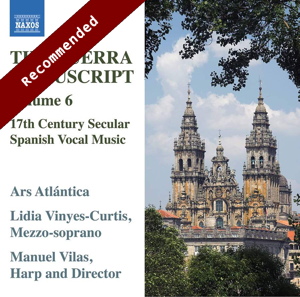
The Guerra Manuscript Volume 6: 17th Century Secular Spanish Vocal Music
Ars Atlántica/Manuel Vilas rec. 2015, Iglesia de San Vicente de Pombeiro, Ferreira de Pantón (Lugo), Spain
Texts available at Naxos website
Naxos 8.574390 [71]
In 2011 Naxos released the first disc of a project concerning the complete recording of an important manuscript, known as the Manuscrito Guerra, after José Miguel de Guerra (1646-1722), scribe of the Royal Chapel from 1677 to shortly after 1680. It is likely that the manuscript was copied around 1680. The quality of the paper and the precision with which the music was written down suggest that it was destined for royal or aristocratic circles. The collection comprises 111 folios with one hundred songs, so-called tonos humanos. All are anonymous, but through a comparison with other sources the composers of a number of songs could be identified. It turned out that most of the main composers of secular songs of the 17th century are represented. Among them are Juan Hidalgo, José Marín, Juan de Navas, Cristóbal Galán, Juan Del Vado and Matías Ruiz.
The present disc brings this project to a close. We get seventeen songs and one piece that has already been performed in its original scoring, but is included here in a version for harp solo. The latter instrument is one of the options with regard to the accompaniment. In previous volumes some songs were accompanied with theorbo or guitar, and now and then a viola da gamba participated. It is notable that the performances were not intended for release on disc in the first place; the recording of the present programme took place in 2015 during a festival. It is a matter of good fortune that Naxos was willing to release these discs, and Manuel Vilas rightly expresses his appreciation at the close of his liner-notes.
José Ángel Vilas Rodriguez, in his liner-notes to the second volume, sums up the features of the tono humano: “precise and regular rhythms, clear melodies and harmonies aiding textual articulation, a tendency towards syllabic style, an absence of Italianate virtuosic vocal ornamentation and limited use of freer, recitative-like passages”. Most songs comprise a number of stanzas (coplas) and a refrain (estribillo), although there are exceptions. Moreover, as Manuel Vilas points out in his liner-notes to Volume 4, in most cases it is left to the performer to decide where and when to insert the refrain.
A number of songs were originally intended as part of stage works. Juan Hidalgo was one of the main composers of music for the theatre in 17th-century Spain. In some cases the songs were adapted. ¿Juegas, Florilla? by was originally written as a dialogue between a shepherd and a shepherdess in Contra el amor desengaño, a zarzuela by Calderón de la Barca. In the Guerra manuscript it is a song for a solo voice. Another song by Hidalgo, Al cristal, mortales venid, appears in El templo de Palas, a play by Francisco de Avellaneda; there it has only one stanza, whereas in the Guerra manuscript it has six.
Some other songs are notable for specific features. One of them is the anonymous En el trono de esmeraldas, which opens the programme, as it has two refrains instead of the usual one. Two songs are written in recitativic style, which – as Vilas writes in his liner-notes – is different from the Italian-style recitative. The first is the anonymous Llega esperado prodigio, the second Hidalgo’s ¿Que piedad ni que favor?, another dialogue, between Apollo and Pallas, but obviously sung by a single voice here, as was undoubtedly the intention.
For a long time the secular music written in Spain in the 17th century has been more or less ignored. That has changed in the last decades, and Manuel Vilas has substantially contributed to the revival of this part of Spain’s musical heritage. The Guerra manuscript is one of the main sources of the tono humano, the Spanish equivalent to the Italian aria. It is different, as Vilas Rodriguez, quoted above, points out, but it has a beauty of its own. It has a unique character, which is perfectly explored during this project.
The quality of the music is one thing; it can only touch the listener if it is performed in a technically and stylistically convincing manner. I am happy to say that the level of each disc was excellent and I have enjoyed all five previous discs. This sixth and last volume is no exception. I did not know the mezzo-soprano Lidia Vinyes-Curtis, who sings all the songs on this disc, and I am impressed by what she does here. She has a lovely voice, and she sings with great subtlety and sensitivity. The character of each song comes out perfectly, and everything sounds completely natural. Manuel Vilas is once again the ideal accompanist on the harp.
I give this disc a special recommendation, but that actually concerns the entire project, which is undoubtedly one of the most important of recent years, as it brings a large repertoire of vocal treasures to the attention of the musical world. Let’s hope that more tonos humanos are going to be recorded in the near future.
Johan van Veen
www.musica-dei-donum.org
twitter.com/johanvanveen
Help us financially by purchasing from


Contents
anon
En el trono de esmeraldas
Y con servir a clori
Juan Hidalgo (1614–1685)
Jilguerillo que al alba saludas
anon
Llega esperado prodigio
De Fílida la beldad
Juan Hidalgo
Atiende y da
anon
Yo soy amor
Este dolor
Mas que amante
Por más que la noche fría
Si a las deidades
Una niña pregono
Juan Hidalgo
¿Juegas, Florilla?
Al cristal, mortales, venid y llegad
Si los celos se hallan
¿Qué piedad ni qué favor?
anon
Pajarillos que alegres cantáis
Juan Hidalgo
En la ruda política vuestra


















